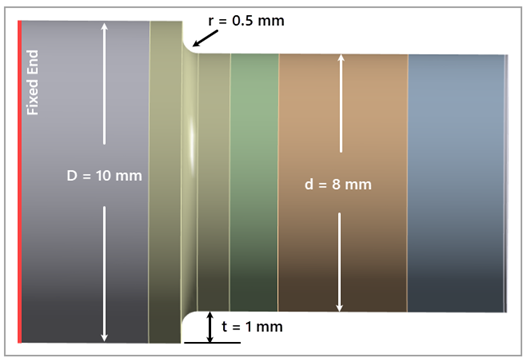VM-LSDYNA-BENCHMARK-005
VM-LSDYNA-BENCHMARK-005
Stress Concentration in Stepped Shaft under Torsion
Overview
| Reference: | Pilkey, W. (1997). Peterson's stress concentration factors (2nd ed., p.166). John Wiley and Sons. |
| Analysis Type(s): | Explicit Dynamics with Workbench LS-DYNA |
| Element Type(s): | Solid |
| Input Files | Link to Input Files Download Page |
Test Case
A stepped shaft with a fillet radius is subjected to pure torsion. A linearly elastic, isotropic material model was used for the shaft, with a Young's modulus (E) of 200 GPa and Poisson's ratio of 0.3. Determine the nominal shear stress at the outer diameter in the smaller diameter portion of the shaft and the maximum shear stress at the fillet.
| Material Properties | Geometric Properties | Loading |
|---|---|---|
|
E = 200 GPa ν = 0.3 |
D = 10 mm d = 8 mm t = 1 mm r = 0.5 mm |
T = 10000 Nmm |
Analysis Assumptions and Modeling Notes
The closed form solution equations for the nominal shear stress in the outer surface of the smaller shaft (τnom) and maximum shear stress in the fillet radius (τmax) are provided in Pilkey (1997):
Note that Kts was determined from the series of equations provided in the reference. Substituting for the given values above, τnom = 99.47 MPa, and τmax = 150.3 MPa.
The load application was defined over 0.01 seconds (the torque was ramped from 0 to 10,000 N over 0.005 seconds then constant for 0.005 seconds).
The element used was LS-DYNA Explicit Tet 13 with an element size of 2 mm.
Results Comparison values are reported for the Windows 11 platform.




